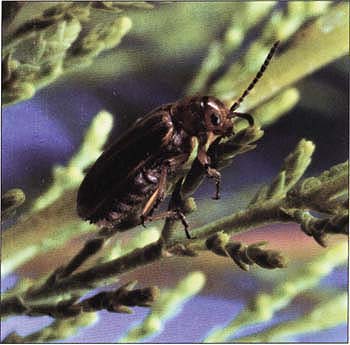All Issues
Science briefs
Publication Information
California Agriculture 55(4):7-7.
Published July 01, 2001
PDF | Citation | Permissions
Full text
New biological control agent released against invasive saltcedar
One of the West's most noxious wildland pests — a nonnative tree called saltcedar that invades riverbanks, pushes out native willows, chokes streams and impoverishes riparian habitat — is about to get the unwanted attention of a Chinese leaf beetle (Diorhabda elongata). In May, a team of biologists from UC Berkeley and the U.S. Department of Agriculture's (USDA) Agricultural Research Service in Albany, Calif., released the small black-and-yellow striped beetle in the Owens Valley.
“We hope that the beetle and a leafhopper that already lives on the trees will give saltcedar a one-two punch to knock it out,” says ecologist Tom L. Dudley of the UC Berkeley Department of Integrative Biology, who heads the vegetation section of the Saltcedar Consortium, a task force of agencies and stakeholders from eight Western states.
The beetle is one of only a handful of natural enemies released in biological control programs to control wildland weeds, compared to more than 100 targeting agricultural plant pests, Dudley says. In addition, most biocontrol releases have targeted herbaceous weeds, not woody plants like saltcedar.
The quarter-inch-long beetle is a good prospect for biocontrol of saltcedar because both larvae and adults feed exclusively on the plant, and the adults produce two or more generations of offspring per year. In addition to eating green vegetation, the beetles create leaf wounds that allow water to escape, causing branches to wither and die.
A 3-year test in the field with beetles confined to cages showed that the beetle can survive the winter and reproduce, and that it effectively defoliates saltcedar.
Some 10 saltcedar species were introduced into the United States since the early 19th century as ornamentals, windbreaks or to stabilize soil. Since then two species, Tamarix parviflora in coastal and central California and Tamarix ramosissima in more arid areas, have invaded river floodplains and lake shores throughout the West, forming dense thickets that can restrict stream flows and cause flooding and erosion. Saltcedar occupies more than 1 million acres of western land today.
Chinese leaf beetles (Diorhabda elongata) were released in Owens Valley as a biocontrol against nonnative saltcedar trees, which are damaging riparian habitat across the West.
Saltcedar also competes with native plants, such as willow and cottonwood; sucks up twice the water that willow does; and draws salt from deep in the soil and deposits it on the surface, killing understory plants. It supports fewer insects than native vegetation, and fewer riparian-dependent migratory birds. Cows won't touch it, and it interferes with recreational access to public and private rivers and lakes. Herbicides and bulldozing have been ineffective because the tree grows back.
Supporters of the consortium include several water resource agencies and cities like Woodland, which has suffered frequent floods as a result of saltcedar infestation at Cache Creek. Other consortium members include UC Davis, Texas A & M University, New Mexico State University, University of Wyoming, U.S. Bureau of Land Management, U.S. Fish and Wildlife Service, USDA's Animal and Plant Health Inspection Service, U.S. Geological Service and other cooperators.
“This will be the most intensively researched biological control program ever conducted in the United States or any other country to evaluate the success of an introduced insect in establishing and affecting a targeted weed, and to document the recovery process of riparian ecosystems impacted by nonindigenous pests,” Dudley says.





